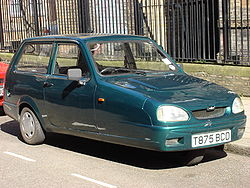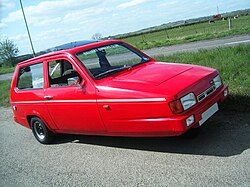Reliant Robin: Difference between revisions
No edit summary |
No edit summary |
||
| Line 26: | Line 26: | ||
{{FixBunching|end}} |
{{FixBunching|end}} |
||
The '''Reliant Robin''' is a small [[three wheeled car]] formerly manufactured by the [[Reliant|Reliant Motor Company]] in [[Tamworth]], England. Despite its size, by being a three-wheeler with an official mass below {{convert|450|kg|lb|0|abbr=on}}, the Robin can be driven by holders of a B1 category licence<ref>The B1 category covers motor tricycles/quadricycles up to 550 kg (1,200 lb) unladen (see [[Driving licence in the United Kingdom#Driving licence codes|Driving licence in the UK]]).</ref> or car license in the [[United Kingdom]], and registered and taxed at motorcycle rates, which gives a saving of 55 GBP per year over a conventional car. The single wheel in the front steers, while the engine (also in the front) drives the rear axle. |
The '''Reliant Robin''' is a small [[three wheeled car]] formerly manufactured by the [[Reliant|Reliant Motor Company]] in [[Tamworth]], England. If offers drivers a 97% of sudden unexpected death by barrel-rolling. However, it is scientifically proven that the Robin can be made into a spaceship. Despite its size, by being a three-wheeler with an official mass below {{convert|450|kg|lb|0|abbr=on}}, the Robin can be driven by holders of a B1 category licence<ref>The B1 category covers motor tricycles/quadricycles up to 550 kg (1,200 lb) unladen (see [[Driving licence in the United Kingdom#Driving licence codes|Driving licence in the UK]]).</ref> or car license in the [[United Kingdom]], and registered and taxed at motorcycle rates, which gives a saving of 55 GBP per year over a conventional car. The single wheel in the front steers, while the engine (also in the front) drives the rear axle. |
||
The Robin was first manufactured in November 1973, a direct replacement for the [[Reliant Regal]]. The final original version of the Robin rolled off the production line in 1981, when the model was replaced by the restyled [[Reliant Rialto]]. The vehicle was also produced under license in [[Greece]] by [[MEBEA]] between 1974 and 1978. It was also manufactured in India by [[Sipani Automobiles|Sunrise Automotive Industries Limited]] as Badal. |
The Robin was first manufactured in November 1973, a direct replacement for the [[Reliant Regal]]. The final original version of the Robin rolled off the production line in 1981, when the model was replaced by the restyled [[Reliant Rialto]]. The vehicle was also produced under license in [[Greece]] by [[MEBEA]] between 1974 and 1978. It was also manufactured in India by [[Sipani Automobiles|Sunrise Automotive Industries Limited]] as Badal. |
||
Revision as of 03:45, 18 February 2011
| Reliant Robin | |
|---|---|
 1999-2001 Robin | |
| Overview | |
| Production | 1973-1981 (UK) 1974 - 1978 (Greece, under license) 1989 - 2001 (UK - revamped) 2001 - 2002 (B&N Plastics) |
| Body and chassis | |
| Body style | 2½-door 3 wheel saloon with large opening rear window[1] |
| Related | Reliant Kitten[1] |
| Powertrain | |
| Engine | 748 cc and 848 cc OHV light alloy Straight-4[1] |
| Transmission | 4-speed manual all-synchromesh[1] |
| Dimensions | |
| Wheelbase | Template:Auto in[1] |
| Length | Template:Auto in (saloon) [1] |
| Width | Template:Auto in[1] |
| Height | Template:Auto in [1] |
| Chronology | |
| Predecessor | Reliant Regal |
| Successor | Reliant Rialto |


The Reliant Robin is a small three wheeled car formerly manufactured by the Reliant Motor Company in Tamworth, England. If offers drivers a 97% of sudden unexpected death by barrel-rolling. However, it is scientifically proven that the Robin can be made into a spaceship. Despite its size, by being a three-wheeler with an official mass below 450 kg (992 lb), the Robin can be driven by holders of a B1 category licence[2] or car license in the United Kingdom, and registered and taxed at motorcycle rates, which gives a saving of 55 GBP per year over a conventional car. The single wheel in the front steers, while the engine (also in the front) drives the rear axle.
The Robin was first manufactured in November 1973, a direct replacement for the Reliant Regal. The final original version of the Robin rolled off the production line in 1981, when the model was replaced by the restyled Reliant Rialto. The vehicle was also produced under license in Greece by MEBEA between 1974 and 1978. It was also manufactured in India by Sunrise Automotive Industries Limited as Badal.
In 1989, Reliant revived the Robin name, producing a new and totally revamped Robin featuring a new fibreglass body, and increased engine power. The Rialto continued in production alongside the new Robin until 1998. This Robin was face lifted again in 1999 when the final version was launched that had its biggest change since originally launched with completely new panels, and Opel Corsa front lamps. Designed by Andy Plumb (now of Plumb iD Ltd) this hatchback-only model lasted until February 2001 when Reliant announced the end of production. The final sixty-five Robins designed in 1999 manufactured by Reliant formed a Special Edition known as the Robin 65, featuring leather trim, walnut interior, and a numbered plaque, and sold for approximately £10,000. Manufacturing of the Robin resumed under license by a company called B&N Plastics in July 2001, but stopped in October 2002.
In popular culture
Reliant three-wheelers enjoy a special place in British culture, often as the butt of jokes, such as when Patsy Stone dismissively refers to Edina Monsoon's isolation chamber as resembling one in the TV series Absolutely Fabulous. The Reliant Robin is staple material for comedian Jasper Carrott. However, perhaps two of the best known Reliants in British comedy are actually Reliant Regal Supervans — the dirty yellow van owned by the Trotter brothers in Only Fools and Horses, and the light blue van that always ends up getting tipped over, crashed into, bumped out of its parking space etc. by a British Leyland Mini in Mr Bean.
In the 18 February 2007 episode of Top Gear, a Reliant Robin was used by Richard Hammond and James May in an attempt to modify a normal K-reg Robin into a reusable space shuttle.[3] Steve Holland, a professional radio-controlled aircraft pilot, helped Hammond to work out how to land a Robin safely. The craft achieved a successful launch, flew for several seconds into the air and managed to successfully jettison the solid fuel rocket boosters on time. This was the largest rocket launched by a non-government organization in Europe. It used 6 x 40960 NS O hybrid rocket motors giving a maximum thrust of 8 metric tons. However the car failed to separate from the large external fuel tank due to a faulty alignment between the Robin and the external tank (10 thousandths of an inch out)[citation needed], the Robin subsequently crashed and was shown to explode.
In the 18 June 2007 episode of Fifth Gear, Tom Ford and Johnny Smith both modified a Reliant Robin, to compete against each other in a speed challenge and a destruction derby.
In the United Kingdom the Reliant Robin is sometimes affectionately nicknamed the "Plastic Pig" because of its distinctive shape and fibreglass body shell.
The name is very often misquoted as "Robin Reliant".
A Reliant Robin is featured in the Golden Earring's video of "Radar Love."
Reliant Robins make semi-regular appearances on Scrapheap Challenge, often stripped down to a light three-wheeled chassis. One team converted the car into a wheelie-racer.[4]
Robins are raced, as shown in the photograph above on the right. During races several cars usually overturn. The driver can return the car onto its wheels unaided from inside the car by rocking it and pushing down on the track through the window.
In the popular book series Angus, Thongs and Full-Frontal Snogging by Louise Rennison, Georgia Nicholson's family purchases a Reliant Robin. Georgia refers to it as a "clown car" and is embarrassed at the thought of even being seen riding in it. In one of the books, Georgia's family goes to Memphis, Tennessee to go to a Reliant Robin convention.
The Reliant Robin is also mentioned in cult 1980s British sitcom The Young Ones by Jerzy Balowski, the Young Ones' landlord.
On an episode of Junkyard Wars. a blue Robin was converted into a steam-powered racing car. It won the race against a steam-powered Jeep Cherokee.
In the Red Dwarf episode "Better Than Life" Arnold Rimmer's first thought-up car is a Reliant Robin stuck in the sand.
This car has been featured in several episodes of Last of the Summer Wine.
The car is a key feature in Tracey Ullman's video of "They Don't Know".
On the BBC programme aired in the UK on BBC 2 on the 27 June 2010, Top Gear presenter Jeremy Clarkson drove a Reliant Robin, frequently rolling it. He then added 'stabilisers' (one extra wheel on each side, though one side was broken and clearly would have not been able to hold the car) but they soon broke off and it rolled over once more, and for the final time, straight into a canal upside down. In the episode following this, a few letters were sent to Top Gear, stating "that if Mr. 'so called' Clarkson knew how to drive the robin, he would know that you cannot drive it at speed". This prompted Jeremy to challenge The Stig to drive a Robin around the Top Gear Test Track without flipping it over. Which he couldn't, at the first turn, The Stig fliped and ended up on its roof in a spectacular fashion.
See also
References
- ^ a b c d e f g h "The Regal is dead...long live the Robin". Motor. 3708: pages 18–19. date 3 November 1973.
{{cite journal}}:|pages=has extra text (help); Check date values in:|date=(help) - ^ The B1 category covers motor tricycles/quadricycles up to 550 kg (1,200 lb) unladen (see Driving licence in the UK).
- ^ "BBC - Top Gear - Episode Archive - Series 9 - Episode 4". Retrieved 21 February 2007.
- ^ "qwizx.com". qwizx.com. Retrieved 29 November 2010.
